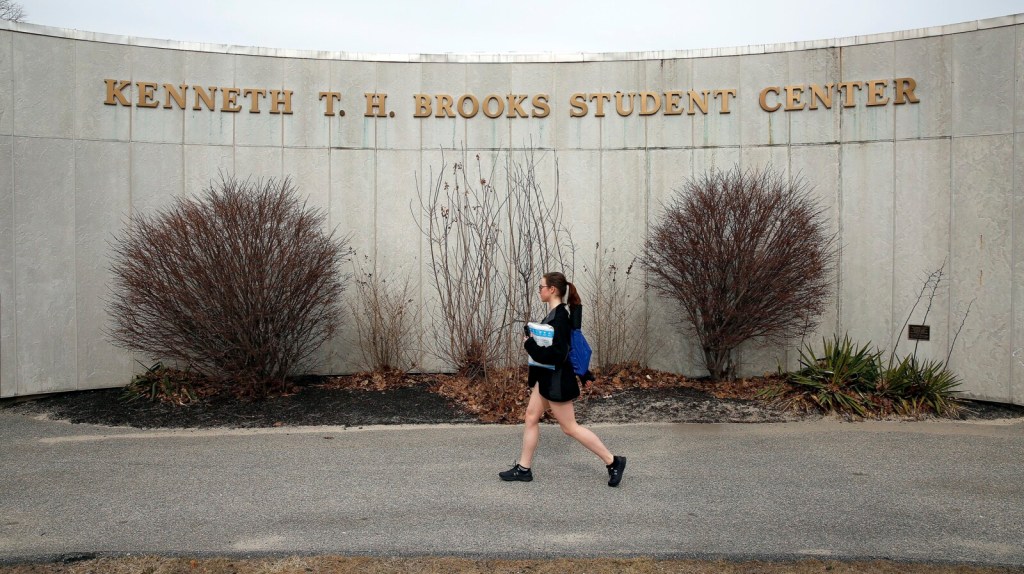Maine
University of Maine System sees success two years after launching Wabanaki history course

Two years after it was introduced, more than 1,000 people, including many teachers, have completed a University of Maine System course about the history of the Wabanaki Nations in Maine, system administrators announced Friday.
The program, launched in November 2022, allows students to learn about Wabanaki Nations history from the Ice Age through today and earn a digital credential demonstrating their understanding of the subject material.
Called the Dawnland credential, the certification was created by John Bear Mitchell, a lecturer and outreach and student development coordinator for the Wabanaki Center and UMaine system’s Native American waiver and educational program coordinator. A citizen of the Penobscot Nation, Mitchell created it to better prepare Maine’s educators to teach Wabanaki studies.
The state of Maine has required K-12 schools to teach Wabanaki studies for more than two decades. Sponsored by then-Rep. Donna Loring, a citizen of the Penobscot Nation, the 2001 Wabanaki Studies Law mandated the subject but did not include funding or resources to support schools in its instruction. The Dawnland credential seeks to fill in some of those gaps.
“It’s great to see there is so much interest in this credential,” Mitchell said in a prepared statement. “My hope, for those who take it, is for them to teach about the tribes that lived on this land before and since Maine became a state from our perspective. To learn about us and to teach about us makes all of Maine a better place to live. By taking away misunderstandings and misrepresented ideology, we can create a true sense of place.”
Many Maine schools have benefited from the Dawnland credential, USM spokesperson Samantha Warren said in a statement. About 300 educators in the RSU 21 district serving Arundel, Kennebunk and Kennebunkport have earned the credential.
In addition, all teacher education students at the University of Maine and the University of Maine at Augusta earn the Dawnland credential before they begin their student teaching.
“Our System’s Dawnland credential equips educators with essential knowledge about the first people of this land we now call Maine and the ability to share with their students the history, culture and contributions of the citizens of the Wabanaki Nations,” said UMS Chancellor Dannel Malloy.
The online course takes about 10 hours to complete and costs $25.

Maine
Mainers asked to report rabbit sightings to help protect endangered New England cottontail
Mainers, if you see a rabbit that might be a New England cottontail or an Eastern cottontail (a non-native species that resembles NEC), Maine Department of Inland Fisheries and Wildlife wants to hear about it.
The New England cottontail (NEC) is Maine’s only native true rabbit, and was once common in southern Maine. However, NEC populations have declined dramatically in Maine and across their entire range due to habitat loss, according to MDIFW, in a news release. Today, NEC are known to occur in just 7 towns: Cape Elizabeth, Scarborough, Wells, York, Kittery, Eliot, and Kennebunk; with a statewide population of less than 400 individuals.
“MDIFW is working with partners to restore Maine’s NEC, but we need more eyes in southern and coastal Maine!” said the release.
MDIFW will conduct surveys in the vicinity of credible NEC sightings to search for currently unknown populations.
“Any new confirmations of the species will greatly enhance our restoration effort by allowing us to protect the population and provide additional opportunities for us to conduct habitat management that will ultimately increase Maine’s NEC population,” said MDIFW.
Please take a photo to submit when possible, take note of the following, and report your sighting online:
- Date
- Time
- Location/Town
- Habitat Description
- Identifying Characteristics- Please do not report known snowshoe hares. Did you observe any features that support identification as an NEC? Find identification tips below.
New England cottontails at a glance
New England cottontails are medium-sized rabbits (14-17 inches long) and weigh in at 1-2.5 pounds. They have dark brown fur with a wash of black-tipped fur, a black edge to their ears. They also have a black spot between their ears though this characteristic is typically not visible from a distance.
Hares are white in winter, but rabbits are brown year-round
It can be surprisingly tricky to distinguish NEC and snowshoe hares during most of the year but identification becomes much simpler in winter! The snowshoe hare goes through a costume change for the snowy months, turning white while NEC retain a brown coat all year. We only need reports of potential NEC so this winter remember to write it down if it’s brown and just enjoy the sight if its white!
Non-native look-alikes
Until recently, Maine was the only state in the northeast that did not have eastern cottontails, a non-native rabbit which is nearly indistinguishable from the NEC. Reporting all brown rabbits in winter not only helps locate new undocumented populations of NEC, it also may help identify areas of eastern cottontail expansion which pose a threat to the recovery of Maine’s only native rabbit.
Click here for more information.
Maine
Maine home sales increased in November
MAINE (WABI) – The Maine real estate market is beginning to see a shift to a more balanced market.
Maine Listings reported about a 6.8% increase in sales of single-family existing homes during the month of November compared to November 2023.
The median sales price reached $385,000, an increase of about 8.5%.
In November, the national price also rose and is now at nearly $411,000.
Copyright 2025 WABI. All rights reserved.
Maine
Here are the 1st babies of 2025

In Maine, several hospitals traditionally report their first births of the year. We will post them here as they are announced.
Michael Nathan Maiato, 7 pounds 12 ounces, was born at 2:55 a.m. Wednesday at MaineHealth Maine Medical Center Portland to parents Paige and Joe Maiato of Kennebunk.
“We are overjoyed with the newest addition to our family,” Joe Maiato said. “What a way to ring in the new year!”
The Maiaitos said they were excited for Michael to meet his 2-year-old brother, Theo.
Myles Hudson Livingood, 6 pounds 10 ounces, was born at 7:05 a.m. Wednesday at Northern Light Eastern Maine Medical Center in Bangor to parents Emily Foss Andrews and Michael Livingood of Bangor.
Kolton Robert, 8 pounds 4.9 ounces, was born at 7:27 a.m. Wednesday at Northern Light Mercy Hospital in Portland to parents Mariah Rouille and Robert Desrosier of South Paris.
-
/cdn.vox-cdn.com/uploads/chorus_asset/file/25672934/Metaphor_Key_Art_Horizontal.png)
/cdn.vox-cdn.com/uploads/chorus_asset/file/25672934/Metaphor_Key_Art_Horizontal.png) Technology1 week ago
Technology1 week agoThere’s a reason Metaphor: ReFantanzio’s battle music sounds as cool as it does
-

 News1 week ago
News1 week agoFrance’s new premier selects Eric Lombard as finance minister
-

 Business1 week ago
Business1 week agoOn a quest for global domination, Chinese EV makers are upending Thailand's auto industry
-

 Health5 days ago
Health5 days agoNew Year life lessons from country star: 'Never forget where you came from'
-
/cdn.vox-cdn.com/uploads/chorus_asset/file/24982514/Quest_3_dock.jpg)
/cdn.vox-cdn.com/uploads/chorus_asset/file/24982514/Quest_3_dock.jpg) Technology5 days ago
Technology5 days agoMeta’s ‘software update issue’ has been breaking Quest headsets for weeks
-

 World1 week ago
World1 week agoPassenger plane crashes in Kazakhstan: Emergencies ministry
-

 Politics1 week ago
Politics1 week agoIt's official: Biden signs new law, designates bald eagle as 'national bird'
-

 Politics6 days ago
Politics6 days ago'Politics is bad for business.' Why Disney's Bob Iger is trying to avoid hot buttons















